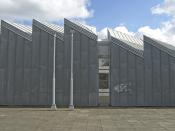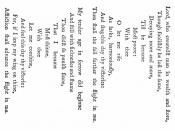Gloria AnzaldÃÂúa's Tlilli, Tlapalli is a hybrid literary work that includes aspects of poetry, fiction and nonfiction. By not transgressing the limits of a single genre, the story gives the reader a better sense of the actual inmixing of the cultures of which it speaks. The story comments upon itself in various places, and AnzaldÃÂúa within the story calls the piece "an assemblage, a montage"à(Geyh 185). It is this "montage"àthat sets the tone for what Linda Hutcheon calls the "transgression of previously accepted limits"à(Hutcheon 9). It is this "transgression of limits"àthat the reader must identify in order to understand Tlilli, Tlapalli. The story is the apparent assimilation of (literary) art, and in that offers the reader a look into an interlacing of cultures, while also offering a personal narrative in what appears to be the author's own voice. The story blends boundaries together to create this sense of blended cultures and to separate itself from the traditionally static cultural descriptions.
Tlilli, Tlapalli opens with summary narrative given by a first person narrator. By doing this, AnzaldÃÂúa lays a foundation for the rest of the story. The narrator, in just the third paragraph, tells the reader how, when she tells stories, she "learned to give [them in] installments"à(Geyh 184). It is not long after this that the story gets its first subheading (to pave the way for a new installment) "Invoking Art"ÃÂ, and thus creates the illusion of an essay, and not a personal narrative. An essay - factual, persuasive, or argumentative - in some respect contradicts the very form of a typical narrative. The author writes "I realize down is up"æI recognize"æoppositions can propel"æ"à(Geyh 191). Here, AnzaldÃÂúa is not straying from a postmodern perspective, as according to Linda Hutcheon the term "ÃÂpostmodern' itself can often be replaced with the term "ÃÂcontradictory' (Hutcheon 12).
AnzaldÃÂúa explicitly states in the story: "My "ÃÂstories' are acts encapsulated in time, "ÃÂenacted' every time they are spoken aloud or read silently"àand goes on to call them "performances"à(Geyh185). Here, the reader is given a concrete fusion of literature and theater. This is a blending of genres, which can help the reader to understand AnzaldÃÂúa's images of "totem poles, cave paintings"àwhile also showing us someone that can "wash the dishes, and mop the floor,"àtwo images that exist in opposite cultures (Geyh 185). AnzaldÃÂúa tells the reader that in the Indian culture "the religious, social and aesthetic purposes of art were all intertwined"à(Geyh 184). This blending of cultures is depicted amidst a blending of genres, even while discussing a blend itself.
The story breaks for a paragraph into a third person poetic narration of a single image, a single scene of a woman collecting water from a pump. This image precedes a paragraph that offers a straight analysis of which seems to be without an obtrusive narrator. These two seemingly unrelated, and perhaps noncohesive, paragraphs are brought together by the statements within the latter paragraph itself, which concludes with "picture language precedes thinking in words; the metaphorical mind precedes analytical consciousness"à(Geyh 187). Upon close examination of that single line, the reader is given the fact the preceding poetic paragraph is in fact metaphorical. In the poetic paragraph, the water pump becomes a live animal. It is up to the reader to determine if the water pump is itself metaphorical of something larger, or more important. Ihab Hassan claims "postmodernism veers towards open, playful"ædisjunctive"æ[and] indeterminate forms"àand thus only by reading AnzaldÃÂúa's work from a postmodernist perspective, can we really begin to understand it (Geyh 593). Tlilli, Tlapalli goes so far as to mix Spanish and English to further the concept of interculturaltivity. The concluding paragraph of this story has the narrator sitting at a computer (an obvious first-world cultural identity) accompanied by "a wooden serpent staff with feathers"à(again, an obvious cultural artifact) (Geyh 191). The theme of the inmixing of cultures does not get much more obvious than this scene.
In conclusion, by blending form and genre, as well as language, the author creates a sense of the apparent assimilation of cultures. Tlilli, Tlapalli, taken from a longer selection of AnzadÃÂúa's, can only be understood after the reader has a general understanding of postmodern literature.
Works Cited Paula Geyh et al, "Postmodern American Fiction,"ÃÂ New York: W.W. Norton and Company; 1998.
Linda Hutcheon, "A poetics of postmodernism,"ÃÂ New York: Routledge; 1988.





